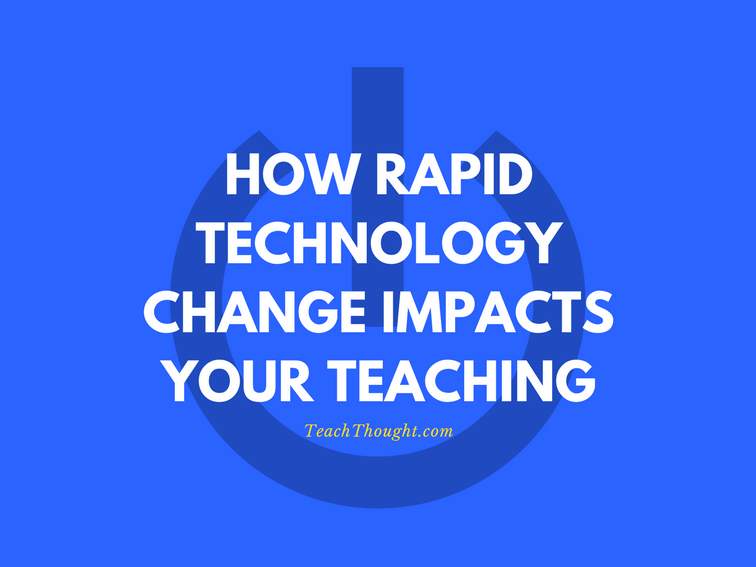How Does Rapid Technology Change Impact Your Teaching?
by Terry Heick
In an increasingly digital world (or increasingly digital human experience anyway), rapid technology change is a fact of life.
And these threats aren’t limited to business disruption, the safety of your data, or the digital footprint of your children. This kind of change also introduces significant threats to education.
There is likely very little that can be actively done to reduce these threats on a macro scale other than impact them financially as consumers, as they are first economic issues.
But we can begin to understand them better as teachers.
How Rapid Technology Change Impacts Your Teaching
1. Rewards teachers that think like designers
Rapid technology change can create a false dichotomy–or falsely dichotomous positions: those for and against technology in education.
Overall, the mess that is proliferation, fragmentation, and short shelf-life of education technology seems justify naysayers that stand on the periphery–arms neat new technology. In some ways, thus argument is similar to not brushing your teeth in the morning because ‘they’re just going to get dirty again.’
But in other ways, these apparent Luddites might have a point. Trendiness is inadequate and wasteful, and has rarely been rewarded in education. Of course, this is a false dichotomy–the idea of being ‘for’ or ‘against’ technology isn’t the point, and we aren’t limited to these sensationalized positions not unlike ‘identity politics.’
Why not, instead, say ‘How might we best design teaching and learning in light of modern technology and social contexts?’
See also Why Some Teachers Are Against Technology In Education
2. Makes it more expensive for you and your school
And when there is indeed adoption in lieu of the pace and nature of rapid technology change, it comes with increased cost–financial and intellectual.
While it is obvious that replacing obsolete software and hardware will cost money, it also creates a moving target for educators trying to implement what is, by its very nature, innovative and original.
Educators are often required to be both first experts in learning, then fluent technology purveyors, pioneering early adopters, and finally master managers of the entire process for 100+ students per semester/year.
3. Can de-emphasize technology if you keep the focus on the function
If technology is always aging, is fragmented across hardware generations (iPhone 8 vs X, for example), and comes in an always-dynamic range of forms, while frustrating, this isn’t always a bad thing.
If there were only Microsoft tablets or iPads or Chromebooks and all other technology ceased to exist, they’d become as ubiquitous as textbooks and paperclips. But as technology remains first consumer-based, its evolution and proliferation aren’t going to slow down.
While a challenge and certainly frustrating, once one can get past the spectacle of it all it encourages a re-centering of the learner–and hopefully curriculum and assessment design that support that learner.
As technology is always moving and elusive, any single platform can’t be fully ‘trusted’–and that’s okay. In this way, such rapid change can have the effect of de-emphasizing the technology itself. We can focus less on what technology and which technology and more on why technology and how technology.
4. It requires you to think differently about PD
Rapid technology changes increases the need for persistent, informal ‘PD.’ As technology advances at a blistering rate, the inertia of institutions of formal learning keeps them from being able to keep up.
Technology policies, teacher growth plans, and even department structures are impotent against this rate of change, and this degree of fragmentation. Yet academic standards and cultural expectation necessitate educators to be on top of their game, and on the cutting edge of all that is learning, not to mention all that is technology.
This makes the curiosity and professional diligence of the educators themselves supplant notions of top-down professional development.
5. Requires our best thinking
For technology to become ‘de-emphasized’ as it constantly morphs, educators will have to change their thinking habits.
Avoiding jumping to conclusions, drawing erratic inferences on too little data, trumpeting biases, refusing to consider alternative solutions are just a few ways the humans behind the technology will have to change. Technology is first a personal and cultural construct no matter how objective educators try to be.
See also The Most Dangerous Phrase In Education
With all the revisions of hardware and software, there must be similar change in how those tools are implemented–which first necessitates an adjustment of our dogma and cognitive blind spots. Otherwise institutions fall into age-old patterns of being led by the same handful of thinkers–those in PLCs with the most charisma, those in administration with the most energy, those at the district or state level with the most influence.
With these broken thinking patterns at the infrastructure-level, the macro-level of education will remain relatively unaltered in lieu of constant shifting at the micro-level.
Rapid technology change creates constantly new circumstances–circumstances that deserve our best thinking to ensure that the technology is serving us and not the other way around.
How Rapid Technology Change Impacts Your Teaching

